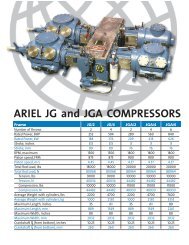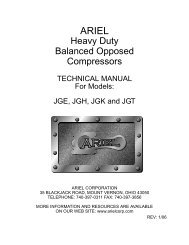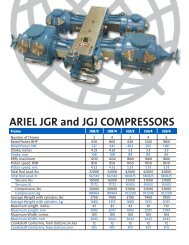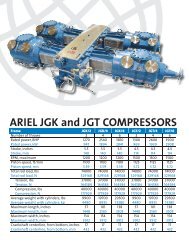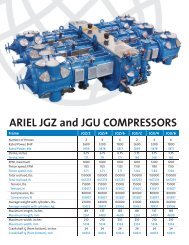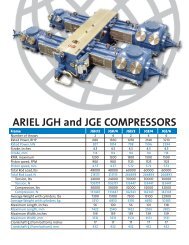Heavy Duty Balanced Opposed Compressors
Heavy Duty Balanced Opposed Compressors
Heavy Duty Balanced Opposed Compressors
Create successful ePaper yourself
Turn your PDF publications into a flip-book with our unique Google optimized e-Paper software.
FOR MODELS: JG AND JGA SECTION 4 - LUBRICATION AND VENTING<br />
gas conditions and list the base rate multiplier at each lube point. If gas conditions were not<br />
supplied, the rates are for clean, dry, 0.65 specific gravity, sweet gas at rated speed and discharge<br />
pressures. If the compressor operating conditions change (such as gas properties,<br />
gas pressures, temperatures or flow requirements or cylinder reconfiguration) the lubrication<br />
rates must be recalculated and hardware changes may be necessary to the force-feed lubrication<br />
system. Consult the following table and your Packager or Ariel.<br />
To set the proper force-feed lubricator pump flow rate, the cycle time indicator on the distribution<br />
block is to be observed. To determine cycle time, time the cycle from flash to flash for<br />
a digital no-flow timer switch (DNFT); or time the cycle from initial movement of the indicator<br />
pin at the fully retracted position, to the time when the pin returns to the fully retracted position<br />
and begins to move back out again for a magnetic cycle indicator assembly.<br />
NOTE: WHEN ADJUSTING THE FORCE FEED LUBRICATION PUMP SETTING FOR<br />
THE APPROPRIATE CYCLE TIME, DO NOT SET THE FLOW RATE TOO LOW.<br />
THE PUMPS CAN BECOME INCONSISTENT WHEN SET TOO LOW.<br />
The force feed lubrication pumps should be capable of delivering 150% minimum of the<br />
“normal” required lube rate for the break in period (set as close as possible to twice the “normal”<br />
rate for 200 hours). Please contact Ariel for assistance if the existing pump is not capable<br />
of the minimum flow rate required.<br />
Used engine oil may be used as long as the new oil specifications meet the listed requirements,<br />
and the oil is appropriately filtered (i.e. 20 micron nominal). Oil viscosity must be<br />
monitored and tested, as follows, for serviceability.<br />
Oil should be changed at regular maintenance intervals (6 months or 4,000 hours), when oil<br />
filter differential pressure exceeds 10 psi (0.7 Bar) for spin-on filters or when oil sample<br />
results indicate the need. A more frequent oil change interval may be required if operating in<br />
an extremely dirty environment or if the oil supplier recommends it. Oil sampling should be<br />
performed on a regular basis to verify suitability of oil for continued service. Degradation to<br />
the next lower viscosity grade below the original viscosity or an increase in viscosity to the<br />
next higher grade requires a complete oil change. Viscosity testing should be performed at<br />
212°F (100°C).<br />
The use of higher viscosity lubricants or specially compounded lubricants can compensate<br />
somewhat for the presence of liquids in the gas stream.<br />
NOTE: WHEN THERE ARE LIQUIDS PRESENT IN THE GAS, THE MOST EFFECTIVE<br />
LUBRICATION OF CYLINDERS AND PACKING REQUIRES REMOVAL OF THE<br />
LIQUIDS BEFORE THE GAS ENTERS THE COMPRESSOR.<br />
THESE LUBRICATION RECOMMENDATIONS ARE GENERAL GUIDELINES. IF<br />
THE RECOMMENDED LUBRICANTS OR FLOW RATES DO NOT APPEAR TO<br />
WORK ADEQUATELY, FLOW RATES AND/OR LUBRICANT TYPES MAY NEED<br />
TO BE CHANGED. PLEASE CONTACT THE LUBRICANT SUPPLIER FOR SPE-<br />
CIFIC LUBRICANT RECOMMENDATIONS.<br />
WARRANTY OF COMPONENT FAILURES WHICH OCCUR WHILE USING<br />
LUBRICANTS WHICH DO NOT MEET THESE SPECIFICATIONS WILL BE SUB-<br />
JECT TO REVIEW ON A CASE BY CASE BASIS.<br />
11/01 PAGE 4 - 7





